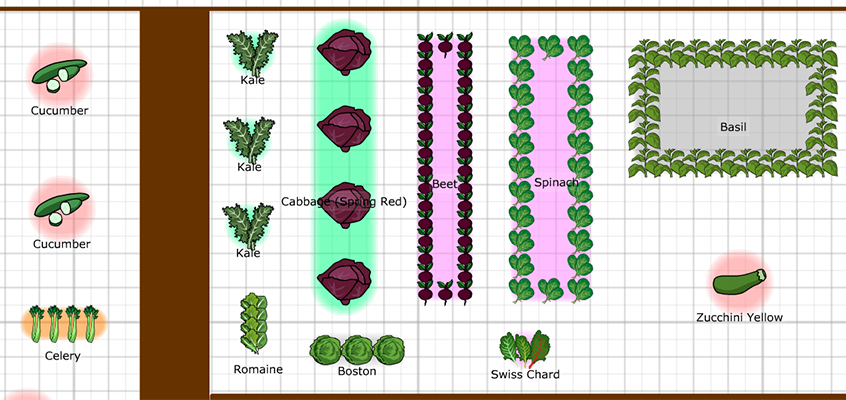When planning your vegetable garden, consider the benefits of crop rotation. Good crop rotation prevents the build up of pests and diseases in the soil and preserves micro-nutrients. For example, legumes (beans and peas) will actually add nitrogen to the soil. While crop rotation will not guarantee that diseases will not occur, it greatly reduces the chance that soil born pests and diseases will ruin your vegetable crop.
Crop rotation is not very difficult, it just takes some advance planning. Vegetables are classified by plant families. Simply, vegetables within the same plant family should not be planted in the same location as they use soils in similar ways and share similar pests and diseases.
The following shows the major plant families and their most common vegetables.
- Alliaceae (Alliums)
chives, garlic, leeks, onions, shallots, asparagus - Brassicaceae (Brassicas)
broccoli, brussel sprouts, cabbage, cauliflower, collards, mustard greens, radish, turnip, rutabaga, kale, kholrabi - Chenopodiaceae (Goosefoot)
spinach, beets, swiss chard, - Compositae
arugula, chicory, endive, escarole, radicchio, lettuce, sunflower - Cucurbitacae (Curcurbits)
cantaloupe, cucumbers, melons, pumpkins, squash, watermelon, gourd - Fabaceae (Legumes)
beans, peas, peanuts - Labiateae
basil - Poaceae or Gramineae (Grasses)
corn, popcorn - Solanaceae (Nightshades)
eggplant, peppers, potatoes, tomatoes - Umbelliferae
celery, carrot, dill, chervil, cilantro, parsley, fennel, parsnip
Plant families should be rotated every year on a four year plan.
Another factor to consider is that some vegetables are heavy feeders (tomatoes, corn, cabbage), others light feeders (potatoes, root and bulb vegetables, herbs) while others build nutrients into the soil (legumes). When planning your crop rotation, try and plant heavy feeders, followed by light feeders and then nutrient builders in the third year. Think heavy – light – feeder when planning your garden. Practically this may not always work and it doesn’t in my garden since I have by far less light feeders than heavy or feeder plants. So I’ve adapted a bit and that means legumes following heavy feeders for me in some years.
| Family | Heavy Feeder | Light Feeder |
|---|---|---|
| Alliaceae | asparagus | chives, garlic, leeks, onions, shallots |
| Brassicaceae | broccoli, brussel sprouts, cabbage, cauliflower, collards, kale, kohlrabi | mustard greens, radish, turnip, rutabaga |
| Chenopodiaceae | spinach, swiss chard | beets |
| Compositae | arugula, chicory, endive, escarole, radicchio, lettuce | sunflower |
| Cucurbitacae | cantaloupe, cucumbers, melons, pumpkins, squash, watermelon, gourd | |
| Fabaceae | beans, peas, peanuts | |
| Labiatea | basil | |
| Poaceae | corn | |
| Solanaceae | eggplant, peppers, tomatoes | potatoes |
| Umbelliferae | celery | carrot, dill, chervil, cilantro, parsley, fennel, parsnip |
The key to managing all of this is to carefully planning of your vegetable garden each year. To design a vegetable garden, you should sketch out your plan, dividing the garden into major sections. Rotate your families among these sections every 4 years. Rotate as well as possible following the heavy – light – feeder routine.
I use an online garden planner from growveg.com. I can keep copies of my plans from previous years, the planner tells you what families different vegetables belong to and you can even set up your plans to warn you if you have planted the same family in that spot withing 2, 3 or more years — whatever rotation period you set up. It does cost $25US a year but I find it well worth the cost. You can have a 30 day free trial to try out the planner, that just won’t keep track of your rotation however keeping a printout would work too!
